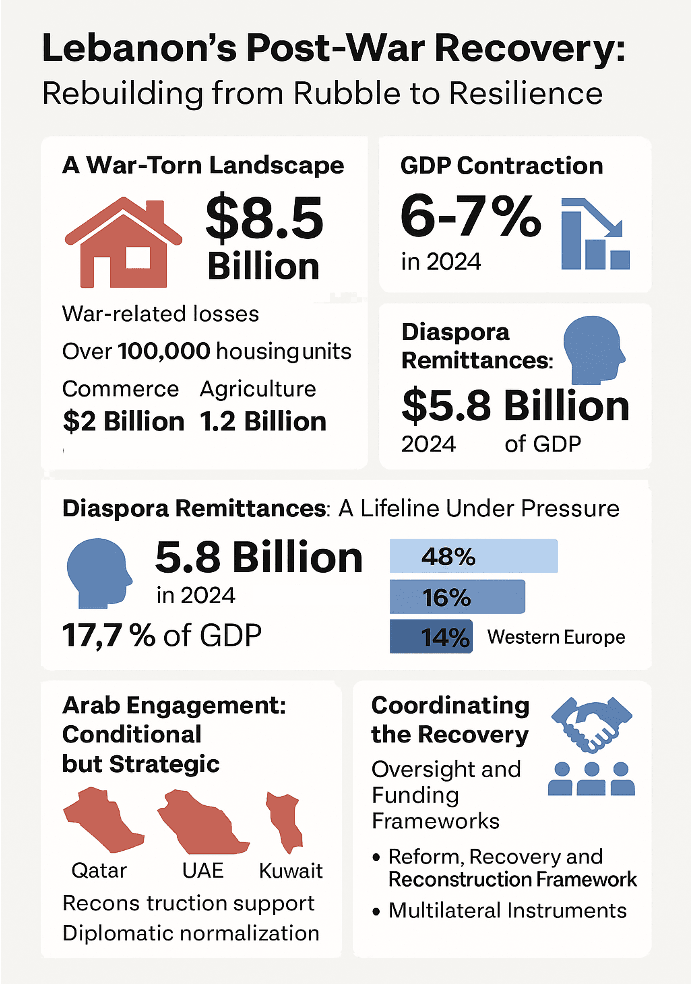Article
PoliticsSocialLebanon’s Post-War Recovery: Rebuilding from Rubble to Resilience
Published on May 13, 2025

By: Ziad Hariri
Share This
Font Size
Introduction
Lebanon’s 2024 war with Israel inflicted devastating physical and economic damage on a country already in a state of protracted crisis. The conflict deepened an already dreadful financial collapse, eroded fragile institutions, and exacerbated social instability. The post-war landscape demands not only physical reconstruction but also systemic reform. Yet, amid the devastation, a unique opportunity exists to rebuild Lebanon on more sustainable, equitable, and transparent foundations—if the country can mobilize coordinated domestic will and secure international support, particularly from Arab states and its expansive diaspora.
A War-Torn Landscape
According to the World Bank’s Rapid Damage and Needs Assessment (RDNA), released in November 2024, Lebanon suffered approximately $8.5 billion in war-related losses, combining direct physical destruction and economic output disruption. Housing was hit hardest: over 100,000 units were partially or fully destroyed, accounting for nearly $3.2 billion in losses. Commerce, industry, and tourism experienced an additional $2 to $3 billion in losses, while the agricultural sector endured $1.2 billion in damage.
By early 2025, the World Bank estimated total recovery needs between $11-$14 billion, with $6.8 billion required for physical reconstruction-including $4.6 billion earmarked for housing-and $7.2 billion to address economic recovery and livelihood restoration. The national GDP contracted by 6–7% in 2024, reflecting the falling impacts of disrupted supply chains, collapsed infrastructure, and mass displacement. Core sectors-such as energy, transport, and water systems-also sustained significant damage, although detailed assessments are still forthcoming.
Human Impact and Displacement
The human toll of the war was severe. The United Nations Office for the Coordination of Humanitarian Affairs (UNOCHA) reported approximately 4,000 civilian fatalities and over 820,000 internally displaced persons (IDPs), many of whom were hosted by relatives or temporary shelters. The economic shock also hit labor markets hard: an estimated 166,000 jobs were lost, resulting in $168 million in lost wages during 2024.
Diaspora Remittances: A Lifeline Under Pressure
Amid currency devaluation, inflation, and frozen bank deposits, Lebanon’s diaspora has continued to serve as a vital lifeline for millions of families. In 2024, the World Bank reported a decline in remittance inflows to $5.8 billion, down from $6.7 billion in 2023. Despite this dip, remittances still accounted for 17.7% of Lebanon’s GDP, placing the country among the highest per capita recipients of remittance flows worldwide. In 2021, this figure peaked at over 30%, underscoring the growing reliance on diaspora fund amid institutional failure.
Remittance sources remain geographically concentrated: Gulf Cooperation Council (GCC) countries—primarily Saudi Arabia, the UAE, and Kuwait—contributed 48% of remittances in 2021, followed by North America (16%) and Western Europe (14%). Just five countries—the United States, UAE, Saudi Arabia, Australia, and Kuwait—accounted for 64% of total inflows. These funds are critical not only for household stability but also as potential future capital for investment, should Lebanon restore political and financial credibility.
Arab Engagement: Conditional but Strategic
In the aftermath of the war, Arab Gulf states have cautiously reengaged with Lebanon. Their readiness to support recovery remains tied to the implementation of structural reforms.
- Qatar reiterated its commitment to reconstruction, conditional on governance reform. It has already extended financial assistance for fuel and army salaries, reflecting its continued engagement.
- The United Arab Emirates resumed in May 2025 flights to Beirut, signaling a normalization of diplomatic ties. The Abu Dhabi Fund for Development is exploring joint infrastructure and development initiatives.
- Kuwait, historically one of Lebanon’s largest Arab donors, has signaled support through multilateral channels, continuing its post-2006 model of indirect aid and technical cooperation.
These diplomatic overtures highlight that while donor fatigue persists, Arab engagement is not off the table. However, aid is now inextricably linked to Lebanon’s willingness to implement fiscal discipline, tackle corruption, and limit non-state military influence.
Coordinating the Recovery: Oversight and Funding Frameworks
Rebuilding Lebanon demands more than donor pledges-it requires robust institutional mechanisms to guarantee accountability and impact. Fortunately, Lebanon can build upon existing platforms:
- The Reform, Recovery and Reconstruction Framework (3RF), launched after the 2020 Beirut Port explosion, and the accompanying Lebanon Financing Facility (LFF), offer models for pooled funding and World Bank-administered oversight. These frameworks provide transparency and multi-stakeholder input, but require renewed political backing to scale effectively.
Multilateral instruments, including the IMF’s Rapid Financing Instrument (RFI), Post-Conflict Assistance, and the World Bank’s Post-Disaster Needs Assessments (PDNAs), are already being explored. These tools offer Lebanon a way to align recovery efforts with global best practices and signal readiness to absorb donor support effectively.
Conclusion: A Defining Moment
Lebanon’s post-war recovery is projected to cost between $11 and $14 billion—a daunting figure given the country’s fiscal insolvency and trust deficit. Yet the scale of need is matched by a rare opportunity to rebuild differently. Diaspora support remains strong but conditional on restored confidence. Arab states are willing to assist but expect accountability. And international partners are looking for clear frameworks before mobilizing larger financial packages.
To seize this moment, Lebanon must act. Transparent recovery planning, robust donor coordination, and inclusive implementation—especially through municipalities and civil society—can convert devastation into an inflection point. If Lebanon is to reemerge as a viable, sovereign state, this recovery must do more than patch holes; it must lay the groundwork for economic justice, social resilience, and political renewal.

Share This
Contact
If you have any query about our service please contact with us
- +961 3 727 636
- infore-co-de.com
Popular Articles
June 08, 2025
From Balance to Alignment: How the 1967 War Redefined U.S. Foreign Policy in the Middle East
By Ziad Hariri
June 09, 2025
اللامركزية الإدارية في لبنان: مسار الإصلاح، التحديات، وآفاق التطبيق
By Ziad Hariri
August 17, 2025
Lebanon’s Last Chance: Disarming Nonstate Actors in a Post-War Transition
By Ziad Hariri